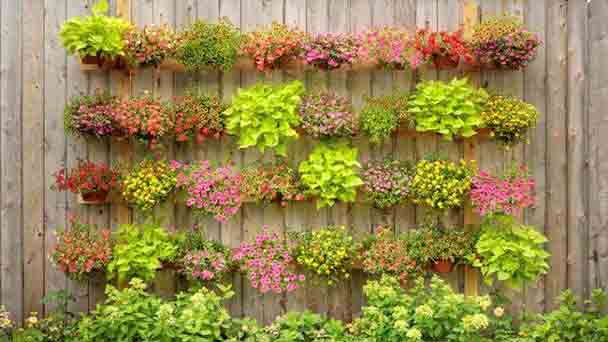Tips for vertical vegetable garden
Written by Joy
Sep 27 2020

If you have a balcony, adding some vertical gardening ideas can allow you to grow more flowers and more vegetables without looking crowded. Vertical gardening can give you a big gain from your small balcony.

Vertical gardening adds a facade to indoor or outdoor planting spaces. Whether you are building a vertical garden or a vegetable garden, you can expand the planting area in the third dimension with a small balcony. Vertical gardens are now considered by many to be one of the hot new garden trends. However, the application of vertical gardens has existed a long time ago. Vines on fences, creepers on piers on walls, etc. vertical garden applications abound. Now the so-called vertical garden is more artistic, modeling and holistic. The vertical garden element can attract people's attention to a certain area, and it can also cover up unobtrusive areas. This gardening style is applicable to any garden indoors or outdoors.
Types of vertical gardening structures
There are many types of vertical gardening structures. It can be a vertical shelf placed on the ground, a vertical structure hung on a wall, an iron frame hung on a balcony guardrail, or a hanging pot structure hung on the roof...It can also be The vertical structure hanging on the wall has simple structures such as barbed wire hanging, wooden frame tray, wooden frame wire ring, iron window wire ring and so on. One structure is fixed on the wall, and one structure connects the vertical shelf and flower pot. The area of the wall is not smaller than the ground, and the wall can be used rationally with a vertical structure.
The form of hanging basin can be pasted to the wall and hung on a barbed wire or wooden frame, or it can be hung in the air. Pieces of hanging plants form a small hanging garden. A simple drip irrigation system can be installed in the hanging pot to facilitate watering. Utilizing the roof area, the area that can be planted with flowers and plants is as much as double.
Options for planting containers
There are also many options for planting containers, such as conventional plastic basins, pottery basins, porcelain basins, iron buckets, etc., unconventional DIY products such as coconut shells, plastic bottles, etc. We can use the materials around us, give full play to our imagination and creativity, and make reasonable use of space structure and lighting factors to form a vertical structure planting area suitable for plant growth. If you want to make your balcony taller, a wall garden is a good choice.
Succulent photo frame
You'd better fix your vertical gardening structure in place before planting to avoid disturbing the roots or stems of the plants. Plants that have weight should be paired with structures that have a large bearing capacity. Vertical gardens will block the light and affect the growth patterns of nearby plants.
Location of the vertical garden
The location of the vertical garden is very particular. Plants grow differently on vertical gardens. Such as climbing roses, it needs to be physically attached to the bracket or wall; such as morning glory, it can be wrapped around the shelf.
Plants grown in vertical gardens may require more frequent watering and fertilization, and they perform more photosynthesis and transpiration than plants grown in flat pots.
In the selection of plants, it needs to be decided according to the lighting conditions of the vertical garden.
Normal light
With good light conditions, you can choose annual flowering vines that will not become too burdensome, such as morning glory, clematis, and vine roses. You choose perennial vines that are easy to plant, such as ivy, radish, spider plant, etc. For fruits and vegetables, you can choose peas, tomatoes, beans, cucumbers, grapes, etc.
Vertical gardening is closer to life, not so tall, but mostly novel. All kinds of amazing little ideas add artistic sense to the little balcony.
Latest Updated
- Benefits of Bugleweed - 7 Science-backed Health Benefits
- Bugleweed Dangers & Side Effects - Is It Poisonous?
- How to Plant Evergreen Trees - What You Should Know
- When to Plant Evergreens - Grow Guide for Evergreen Trees
- 12 Wonderful Evergreen Shrubs for Your Garden
- 12 Popular Evergreen Plants with Pictures for Beginners
- When And How To Prune A Lilac Bush Like a Pro
- How to Grow & Care for Lilac Vine (Hardenbergia Violacea)
- Japanese Lilac Tree (Syringa Reticulata) Care & Propagation Guide
- Shumard Oak Pros and Cons - What to Know
Popular Articles
- Winter maintenance of Antirrhinum Majus
- How to Grow Terminalia Mantaly Tree
- How to Grow and Care for Crossostephium Chinense
- How to grow Antirrhinum Majus in spring
- Peristeria Elata (Dove Orchid) Profile: Info & Care Guide
- Underwatered Snake Plant (Sansevieria Trifasciata) - Signs And How To Fix
- How to Care for Brazilian Jasmine Plant (Mandevilla Sanderi)
- How to Grow & Care for Graptopetalum Purple Delight in Summer
- Rosa Chinensis (China Rose): Plant Growing & Care Tips
- How to Care for Baby Sun Rose (Aptenia Cordifolia)